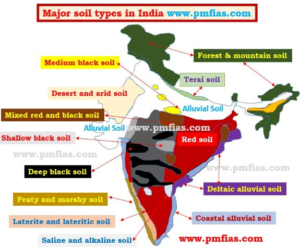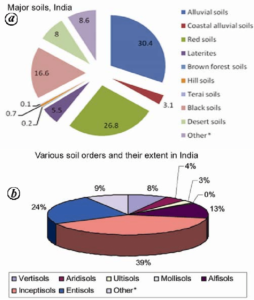Poor soil management will erode food security
GS1, India geography
Article Summary:
- World Soil Day (WSD) 2022, is annually observed on December 5.
- WSD 2022, has guiding theme, ‘Soils: Where food begins’.
Context
Soil: It is a mixture of small rock particles/debris and organic materials/ humus which develop on the earth surface and support growth of plants.
Major Indian soils:
Food security:
- Food security, as defined by the United Nations’ Committee on World Food Security, means that all people, at all times, have physical, social, and economic access to sufficient, safe, and nutritious food that meets their food preferences and dietary needs for an active and healthy life.
- It has following dimensions:
- Availability: It means food production within the country, food imports and the stock stored in government granaries.
- Accessibility: It means food is within reach of every person without any discrimination.
- Affordability: It implies that having enough money to buy sufficient, safe and nutritious food to meet one’s dietary needs.
Importance of healthy soil:
- It is estimated that 95% of our food is directly or indirectly produced on our soils.
- Healthy soils are the foundation of the food system.
- Our soils are the basis for agriculture and the medium in which nearly all food-producing plants grow. Healthy soils produce healthy crops that in turn nourish people and animals. Indeed, soil quality is directly linked to food quality and quantity.
- Soils supply the essential nutrients, water, oxygen and root support that our food-producing plants need to grow and flourish.
- They also serve as a buffer to protect delicate plant roots from drastic fluctuations in temperature.
- Soils help to regulate the planet’s climate by storing carbon and are the second largest carbon sink after the oceans
What WSD 2022, with its guiding theme, ‘Soils: Where food begins means?
- Awareness: It is a means to raise awareness on the importance of maintaining healthy soils
- Ecosystems and human well-being by addressing the growing challenges in soil management
- Encouraging societies to improve soil health
- Management: Advocating the sustainable management of soil.
Soil Degradation:
“Land degradation” is the reduction or loss of the biological or economic productivity and complexity of cropland, pasture, forest and woodlands. This may result from a combination of land uses and processes, including those arising from human activities and habitation patterns. Land degradation may take the form of
- soil erosion caused by wind and/or water;
- deterioration of the physical, chemical and biological or economic properties of soil; and
- long-term loss of natural vegetation.
Land degradation is commonly caused by the mismanagement or over-exploitation of land resources.
- Land degradation is a major global environmental issue of this century because of its adverse impact on agronomic productivity, the environment, and its effect on food security and the quality of life.
- Land degradation is happening at an alarming pace and is affecting regions inhabited by over one-third of the global population.
- This phenomenon contributes to a dramatic decline in the productivity of croplands and rangelands worldwide, thereby, threatening food security and environmental quality.
Main drivers contributing to soil degradation:
- Industrial activities
- Mining
- Waste treatment
- Agriculture
- Fossil fuel extraction
- Processing and transport emissions.
Consequences of soil degradation:
- Soil degradation in some form or another affects around 29% of India’s total land area.
- Nearly 3.7(three point seven)million hectares suffer from nutrient loss in soil (depletion of soil organic matter, or SOM).
- It threatens:
- Agricultural productivity
- In-situ biodiversity conservation
- Water quality
- Socio-economic well-being of land dependent communities.
India’s conservation strategy:
- Five-pronged strategy for soil conservation:
- Making soil chemical-free
- Saving soil biodiversity
- Enhancing SOM
- Maintaining soil moisture
- Mitigating soil degradation
- Preventing soil erosion
- Soil Health Card (SHC) scheme(2015): To address issues of information relating to soil type, soil deficiency and soil moisture content.
- It displays soil health indicators and associated descriptive terms, which guide farmers to make necessary soil amendments.
- Pradhan Mantri Krishi Sinchayee Yojana: to prevent soil erosion, regeneration of natural vegetation, rainwater harvesting and recharging of the groundwater table.
- National Mission for Sustainable Agriculture (NMSA): Promoting traditional indigenous practices such as organic farming and natural farming.
Role of Food and Agriculture Organization of the United Nations (FAO):
- FAO along with National Rainfed Area Authority and the Ministry of Agriculture and Farmers’ Welfare (MoA&FW) to develop forecasting tools using data analytics that will aid vulnerable farmers in making informed decisions on crop choices, particularly in rainfed areas.
- FAO, in association with the Ministry of Rural Development: It supports the Deen Dayal Antyodaya Yojana-National Rural Livelihoods Mission’s (DAY-NRLM) Community Resource Persons.
- It will increase their capacities towards supporting on-farm livelihoods for:
- Adoption of sustainable and resilient practices
- Organic certification
- Agri-nutri-garden
- The FAO works in eight target States: like Madhya Pradesh, Mizoram, Odisha, Rajasthan etc for boosting crop diversification and landscape-level planning.
- FAO is partnering with the State government and the Indian Council of Agricultural Research (ICAR) in Andhra Pradesh: to support farmers in sustainable transitions to agro-ecological approaches and organic farming.
- It will increase their capacities towards supporting on-farm livelihoods for:
Way Forward
- Impacts of soil degradation: They are far reaching and can have irreparable consequences on human and ecosystem health.
- There is a need to strengthen communication channels between academia, policymakers and society for the identification, management and restoration of degraded soils, as well as in the adoption of anticipatory measures.
- Greater cooperation and partnerships: They are central to ensure the availability of knowledge, sharing of successful practices, and universal access to clean and sustainable technologies, leaving no one behind.
- Consumers and citizens: we can contribute by planting trees to protect topsoil, developing and maintaining home/kitchen gardens, and consuming foods that are mainly locally sourced and seasonal.
Mains Question:
- How has the emphasis on certain crops brought about changes in cropping patterns in the recent past? Elaborate the emphasis on millets production and consumption.(UPSC 2018) (200 WORDS, 10 MARKS)





